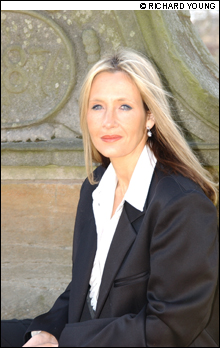
 |
It’s not giving too much away to say that Harry Potter and the Deathly Hallows, the seventh and final book in J.K. Rowling’s magical saga, ends our long enchantment on an appropriately bittersweet note. The book’s body count might resemble something out of The Sopranos, but its message of forgiveness, redemption, and rebirth unabashedly tugs on the heartstrings.
Deathly Hallows is set in the aftermath of Professor Dumbledore’s shocking death at the wand of Professor Snape. The evil Lord Voldemort has gained control of the Wizard government and media; Hogwarts school is under siege. With a price on his head, Harry has gone into the wilderness to regroup, accompanied by his pals Hermione Granger and Ron Weasley. In previous books, Rowling began drawing parallels between the “pureblood”-extolling Voldemort and Hitler; in Deathly Hallows, she makes the Nazi connection explicit, with the persecution of “Mudbloods” (Wizards born of non-wizard parents, like Hermione) and “blood traitors” (pureblooded, anti-Voldemort Wizard families, like the Weasleys). The good guys, the Order of the Phoenix, put up a rag-tag resistance. But all hopes rest on Harry — the orphaned savior of the Wizarding world — to destroy Voldemort, even if that means Harry’s own prophesied death. At the book’s bleakest moments, Harry struggles with despair and doubt (even questioning his faith in his beloved mentor Dumbledore) while trudging toward his inevitable showdown with the Dark Lord.
Deathly Hallows is the darkest, most chilling book of the series. Death itself is almost a character here. It’s well known that Rowling infused the series with her own grief over the loss of her mother. And the new book finds Harry yearning more than ever for the comfort of his parents, James and Lily, and his other departed loved ones. Deathly Hallows is not cozy bedtime reading for the kiddies. Everyone else, though, will probably appreciate the adrenaline rush of the book’s second half, where all the intricate plotting of the series clicks into place. Rowling’s prose may be merely functional, but she’s the consummate storyteller, and she has always known just how much of the yarn to spin in order to keep readers coming back. Fans need not worry that the finale will leave them dangling, however. In Deathly Hallows, Rowling decisively answers some lingering questions, and the effect is much like a magician showing her audience the secret of sawing a person in half.
Deathly Hallows is a satisfying resolution of Rowling’s main themes — good versus evil, tolerance versus prejudice, sacrifice versus self-interest, choice versus destiny. It’s also a fitting end to this coming-of-age tale, as Rowling movingly depicts the 17-year-old Harry’s final passage from childhood to adulthood. In all of the books, Harry is placed in dire situations in which he witnesses mysterious and treacherous exchanges between adults while he remains hidden beneath his father’s old “Invisibility Cloak.” The cloak is a metaphor for the protective veiling of innocence, just as Harry’s eyeglasses are a metaphor for his inability to look beyond the surface; at key moments of the series, Harry sees without understanding and misinterprets based on emotion. In Deathly Hallows, Harry finally learns the lesson that will enable him to fully enter manhood — that appearances can be deceiving. WARNING! SPOILERS AHEAD! With the penultimate book, Harry Potter and the Half-Blood Prince, it became clear that Rowling’s saga was as much about Severus Snape’s journey as it was about Harry’s. The sneering, enigmatic Potions Master is easily Rowling’s most intriguing, complicated character. And when the veil falls from Harry’s eyes for the last time in Deathly Hallows, it brings with it a long overdue comprehension of his arch frenemy’s motives.
How did a “children’s story” become the literary epic of our time? First of all, with a record 8.3 million copies of the final book sold on its July 21 release day, Harry Potter can’t be considered merely a children’s story. Rowling’s dazzling mosaic incorporates shards of myths, fairytales, legends, and ancient and modern history. It carries echoes of the stories of Jesus and King Arthur, of Star Wars and Lord of the Rings, and follows the path of countless Joseph Campbellian hero’s journeys. Harry’s story and the archetypal characters within it feel reassuringly familiar, yet thrillingly new. Yes, the magical setting resonates with 10-year-olds. But the books’ emotional richness and thorny moral questions (Deathly Hallows ambitiously delves into the implications of acting “for the greater good”) resonate with readers of all ages.